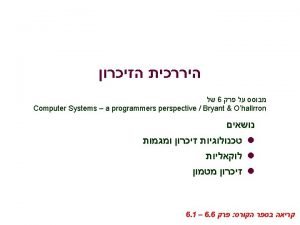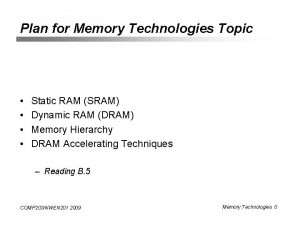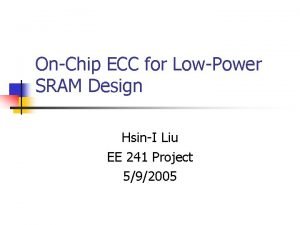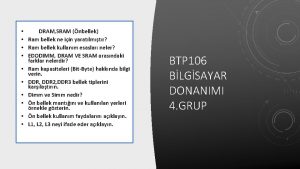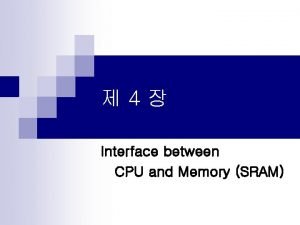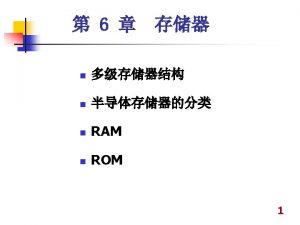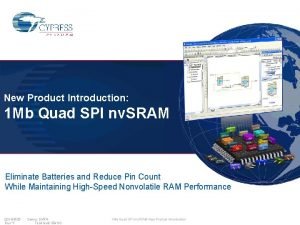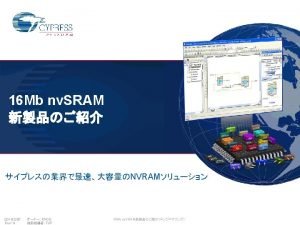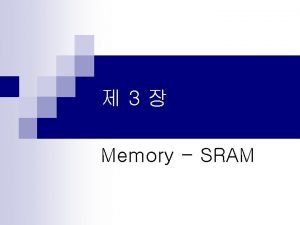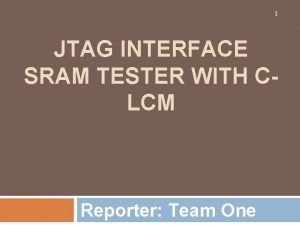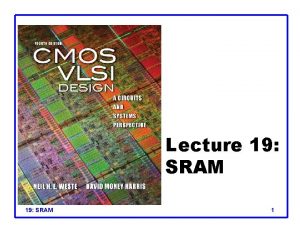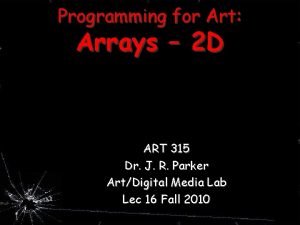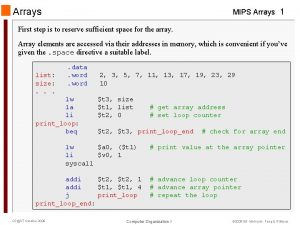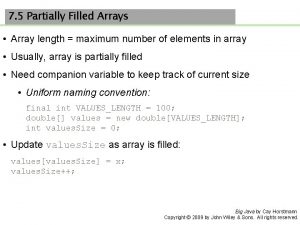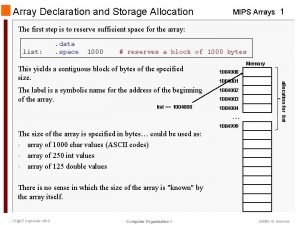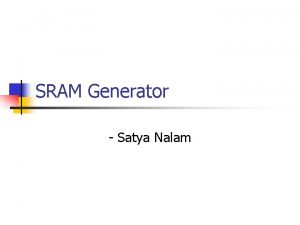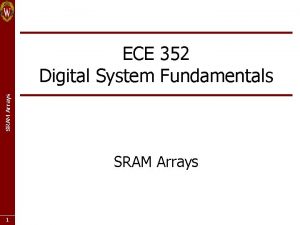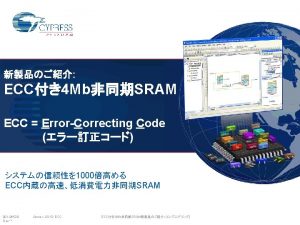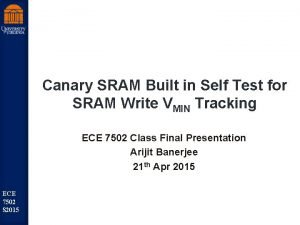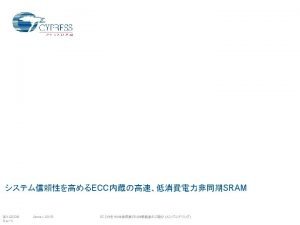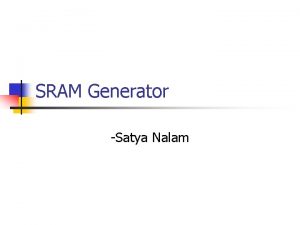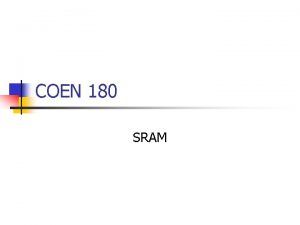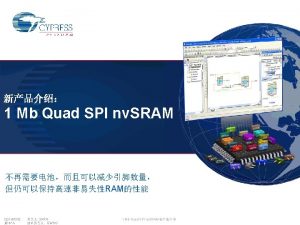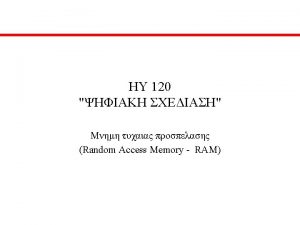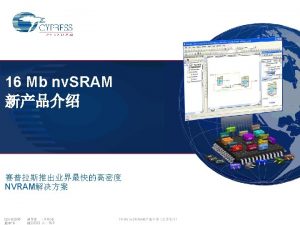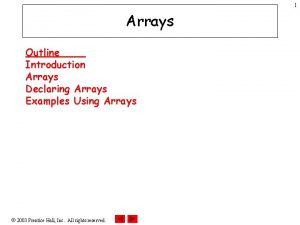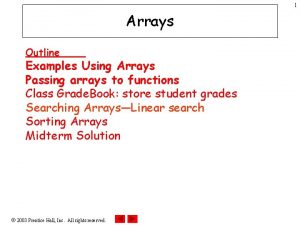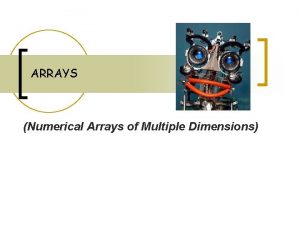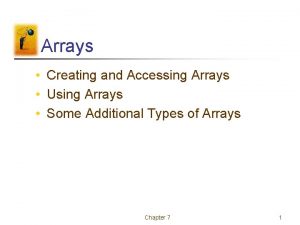Lecture 19 SRAM 1 Outline q Memory Arrays







































- Slides: 39

Lecture 19: SRAM 1

Outline q Memory Arrays q SRAM Architecture – SRAM Cell – Decoders – Column Circuitry – Multiple Ports q Serial Access Memories 19: SRAM CMOS VLSI Design 4 th Ed. 2

Memory Arrays 19: SRAM CMOS VLSI Design 4 th Ed. 3

Array Architecture q 2 n words of 2 m bits each q If n >> m, fold by 2 k into fewer rows of more columns q Good regularity – easy to design q Very high density if good cells are used 19: SRAM CMOS VLSI Design 4 th Ed. 4

12 T SRAM Cell q Basic building block: SRAM Cell – Holds one bit of information, like a latch – Must be read and written q 12 -transistor (12 T) SRAM cell – Use a simple latch connected to bitline – 46 x 75 l unit cell 19: SRAM CMOS VLSI Design 4 th Ed. 5

6 T SRAM Cell q Cell size accounts for most of array size – Reduce cell size at expense of complexity q 6 T SRAM Cell – Used in most commercial chips – Data stored in cross-coupled inverters q Read: – Precharge bit, bit_b – Raise wordline q Write: – Drive data onto bit, bit_b – Raise wordline 19: SRAM CMOS VLSI Design 4 th Ed. 6

SRAM Read q q Precharge both bitlines high Then turn on wordline One of the two bitlines will be pulled down by the cell Ex: A = 0, A_b = 1 – bit discharges, bit_b stays high – But A bumps up slightly q Read stability – A must not flip – N 1 >> N 2 19: SRAM CMOS VLSI Design 4 th Ed. 7

SRAM Write q q Drive one bitline high, the other low Then turn on wordline Bitlines overpower cell with new value Ex: A = 0, A_b = 1, bit_b = 0 – Force A_b low, then A rises high q Writability – Must overpower feedback inverter – N 2 >> P 1 19: SRAM CMOS VLSI Design 4 th Ed. 8

SRAM Sizing q High bitlines must not overpower inverters during reads q But low bitlines must write new value into cell 19: SRAM CMOS VLSI Design 4 th Ed. 9

SRAM Column Example Read 19: SRAM Write CMOS VLSI Design 4 th Ed. 10

SRAM Layout q Cell size is critical: 26 x 45 l (even smaller in industry) q Tile cells sharing VDD, GND, bitline contacts 19: SRAM CMOS VLSI Design 4 th Ed. 11

Thin Cell q In nanometer CMOS – Avoid bends in polysilicon and diffusion – Orient all transistors in one direction q Lithographically friendly or thin cell layout fixes this – Also reduces length and capacitance of bitlines 19: SRAM CMOS VLSI Design 4 th Ed. 12

Commercial SRAMs q Five generations of Intel SRAM cell micrographs – Transition to thin cell at 65 nm – Steady scaling of cell area 19: SRAM CMOS VLSI Design 4 th Ed. 13

Decoders q n: 2 n decoder consists of 2 n n-input AND gates – One needed for each row of memory – Build AND from NAND or NOR gates Static CMOS 19: SRAM Pseudo-n. MOS CMOS VLSI Design 4 th Ed. 14

Decoder Layout q Decoders must be pitch-matched to SRAM cell – Requires very skinny gates 19: SRAM CMOS VLSI Design 4 th Ed. 15

Large Decoders q For n > 4, NAND gates become slow – Break large gates into multiple smaller gates 19: SRAM CMOS VLSI Design 4 th Ed. 16

Predecoding q Many of these gates are redundant – Factor out common gates into predecoder – Saves area – Same path effort 19: SRAM CMOS VLSI Design 4 th Ed. 17

Column Circuitry q Some circuitry is required for each column – Bitline conditioning – Sense amplifiers – Column multiplexing 19: SRAM CMOS VLSI Design 4 th Ed. 18

Bitline Conditioning q Precharge bitlines high before reads q Equalize bitlines to minimize voltage difference when using sense amplifiers 19: SRAM CMOS VLSI Design 4 th Ed. 19

Sense Amplifiers q Bitlines have many cells attached – Ex: 32 -kbit SRAM has 128 rows x 256 cols – 128 cells on each bitline q tpd (C/I) DV – Even with shared diffusion contacts, 64 C of diffusion capacitance (big C) – Discharged slowly through small transistors (small I) q Sense amplifiers are triggered on small voltage swing (reduce DV) 19: SRAM CMOS VLSI Design 4 th Ed. 20

Differential Pair Amp q Differential pair requires no clock q But always dissipates static power 19: SRAM CMOS VLSI Design 4 th Ed. 21

Clocked Sense Amp q Clocked sense amp saves power q Requires sense_clk after enough bitline swing q Isolation transistors cut off large bitline capacitance 19: SRAM CMOS VLSI Design 4 th Ed. 22

Twisted Bitlines q Sense amplifiers also amplify noise – Coupling noise is severe in modern processes – Try to couple equally onto bit and bit_b – Done by twisting bitlines 19: SRAM CMOS VLSI Design 4 th Ed. 23

Column Multiplexing q Recall that array may be folded for good aspect ratio q Ex: 2 kword x 16 folded into 256 rows x 128 columns – Must select 16 output bits from the 128 columns – Requires 16 8: 1 column multiplexers 19: SRAM CMOS VLSI Design 4 th Ed. 24

Tree Decoder Mux q Column mux can use pass transistors – Use n. MOS only, precharge outputs q One design is to use k series transistors for 2 k: 1 mux – No external decoder logic needed 19: SRAM CMOS VLSI Design 4 th Ed. 25

Single Pass-Gate Mux q Or eliminate series transistors with separate decoder 19: SRAM CMOS VLSI Design 4 th Ed. 26

Ex: 2 -way Muxed SRAM 19: SRAM CMOS VLSI Design 4 th Ed. 27

Multiple Ports q We have considered single-ported SRAM – One read or one write on each cycle q Multiported SRAM are needed for register files q Examples: – Multicycle MIPS must read two sources or write a result on some cycles – Pipelined MIPS must read two sources and write a third result each cycle – Superscalar MIPS must read and write many sources and results each cycle 19: SRAM CMOS VLSI Design 4 th Ed. 28

Dual-Ported SRAM q Simple dual-ported SRAM – Two independent single-ended reads – Or one differential write q Do two reads and one write by time multiplexing – Read during ph 1, write during ph 2 19: SRAM CMOS VLSI Design 4 th Ed. 29

Multi-Ported SRAM q Adding more access transistors hurts read stability q Multiported SRAM isolates reads from state node q Single-ended bitlines save area 19: SRAM CMOS VLSI Design 4 th Ed. 30

Large SRAMs q Large SRAMs are split into subarrays for speed q Ex: Ultra. Sparc 512 KB cache – – – 4 128 KB subarrays Each have 16 8 KB banks 256 rows x 256 cols / bank 60% subarray area efficiency Also space for tags & control [Shin 05] 19: SRAM CMOS VLSI Design 4 th Ed. 31

Serial Access Memories q Serial access memories do not use an address – Shift Registers – Tapped Delay Lines – Serial In Parallel Out (SIPO) – Parallel In Serial Out (PISO) – Queues (FIFO, LIFO) 19: SRAM CMOS VLSI Design 4 th Ed. 32

Shift Register q Shift registers store and delay data q Simple design: cascade of registers – Watch your hold times! 19: SRAM CMOS VLSI Design 4 th Ed. 33

Denser Shift Registers q Flip-flops aren’t very area-efficient q For large shift registers, keep data in SRAM instead q Move read/write pointers to RAM rather than data – Initialize read address to first entry, write to last – Increment address on each cycle 19: SRAM CMOS VLSI Design 4 th Ed. 34

Tapped Delay Line q A tapped delay line is a shift register with a programmable number of stages q Set number of stages with delay controls to mux – Ex: 0 – 63 stages of delay 19: SRAM CMOS VLSI Design 4 th Ed. 35

Serial In Parallel Out q 1 -bit shift register reads in serial data – After N steps, presents N-bit parallel output 19: SRAM CMOS VLSI Design 4 th Ed. 36

Parallel In Serial Out q Load all N bits in parallel when shift = 0 – Then shift one bit out per cycle 19: SRAM CMOS VLSI Design 4 th Ed. 37

Queues q Queues allow data to be read and written at different rates. q Read and write each use their own clock, data q Queue indicates whether it is full or empty q Build with SRAM and read/write counters (pointers) 19: SRAM CMOS VLSI Design 4 th Ed. 38

FIFO, LIFO Queues q First In First Out (FIFO) – Initialize read and write pointers to first element – Queue is EMPTY – On write, increment write pointer – If write almost catches read, Queue is FULL – On read, increment read pointer q Last In First Out (LIFO) – Also called a stack – Use a single stack pointer for read and write 19: SRAM CMOS VLSI Design 4 th Ed. 39
 01:640:244 lecture notes - lecture 15: plat, idah, farad
01:640:244 lecture notes - lecture 15: plat, idah, farad Sram vs dram
Sram vs dram Tamara pierre louis
Tamara pierre louis Sram vmin
Sram vmin Vlsi
Vlsi Example of sram
Example of sram Sram
Sram Sram nedir
Sram nedir Cpu sram
Cpu sram 2114 sram
2114 sram Qspi sram
Qspi sram Sram spi
Sram spi Sram vanier application
Sram vanier application Galpat
Galpat Sram address
Sram address Jtag waveform
Jtag waveform Sram column mux
Sram column mux Endereço virtual
Endereço virtual Scolarité insuffisante sram
Scolarité insuffisante sram Scolarité insuffisante sram
Scolarité insuffisante sram Shape memory alloys lecture notes
Shape memory alloys lecture notes Lecture outline meaning
Lecture outline meaning Lecture outline example
Lecture outline example Lecture outline example
Lecture outline example Lecture outline example
Lecture outline example Arrays
Arrays Python parallel arrays
Python parallel arrays Arrays in mips
Arrays in mips Disadvantages of dynamic memory allocation in c
Disadvantages of dynamic memory allocation in c Java partially filled array
Java partially filled array Computer science arrays
Computer science arrays Partially filled arrays
Partially filled arrays Dynamic arrays and amortized analysis
Dynamic arrays and amortized analysis Day 3: arrays
Day 3: arrays Mips declare array
Mips declare array Advantages and disadvantages of arrays
Advantages and disadvantages of arrays Polynomial representation using array in c
Polynomial representation using array in c Parallel array java
Parallel array java Microled arrays
Microled arrays Redundancy array of independent disk
Redundancy array of independent disk

